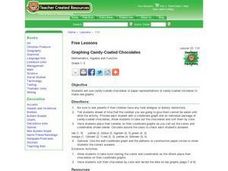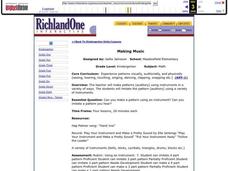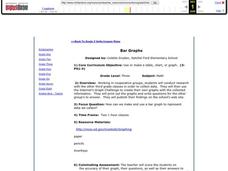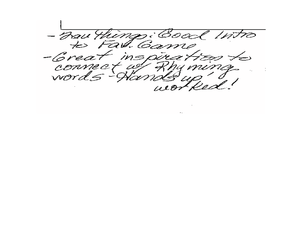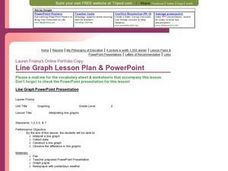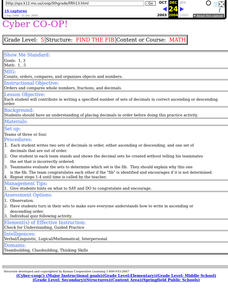Curated OER
Pick a Pet
Students construct a pictograph of favorite pets. For this pets and graphing lesson, students discuss their favorite pet and use animal magazines to find their favorite pets and cut them out. Students create a pictograph using the pictures.
Curated OER
Pocket Change
Students practice identifying coins and their values. In this money identification lesson, students play a game, where they toll a coin, determine the value, and compare totals to win.
Curated OER
Geometry Fun
Students learn the basic definitions of a quadrilateral, parallelogram, rectangle and square and explain the relationship/classification process between them.
Curated OER
Graphing Candy-Coated Chocolates
Students place pieces of candy on their coordinate graphs as the teacher calls out the colors and coordinates embedded in the plan. The teacher circulates around the class to check each student's answers for accuracy.
Curated OER
I. M. Pei and the Geometry of the NGA
Students compare design elements in neoclassical and modern architecture. They review knowledge of triangles and quadrilaterals and design a geometric pattern using Pei's polygons They create a city plan using a variety of lines and...
Curated OER
The Hundred Penny Box
Learners compare how people save money in financial institutions, after reading the story, The Hundred Penny Box. They analyze the advantages of regular saving and how savings grow with compounding.
Curated OER
Music Favorites and Place Value
Fourth graders view CD ads and create a chart about an imaginary CD purchase. For this CD lesson, 4th graders calculate various cost connected with the CD's at the regular price and on sale. Students write a paragraph about...
Curated OER
Making Music
Students create auditory musical patterns. In this patterns lesson, students create a pattern using their hands, feet, dancing, and snapping their fingers. Students use a recorder to recreate a pattern.
Curated OER
Put the Elephant First
Students recreate the order of animals they read about in a book. In this relative positions lesson, students color and cut out pictures of animals in the book. Sudents glue these onto construction paper and line up like the animals...
Curated OER
When is Your Birthday?
Students use data about their birthdays to create graphs. In this collecting and communicating information instructional activity, students make a class list of their birthdays. Students use the information to make a bar graph showing...
Curated OER
How Do You Like Your Eggs?
First graders conduct a poll about how people like their eggs. In this graphing lesson, 1st graders collect data about how they like their eggs. Students use a picture of themselves to place under the type of egg they like. Students then...
Curated OER
Bar Graphs
Third graders investigate bar graphs. In this third grade mathematics lesson, 3rd graders collect and analyze data and use the internet’s Graph challenge to create their own graphs. Students write questions for the other...
Curated OER
Classroom Builder
Students explore music theory by discussing a classic song. In this musical notation instructional activity, students listen to the song "My Favorite Things" and discuss and share their personal tastes with the class. Students practice...
Curated OER
Interpreting Line Graphs
Fifth graders interpret line graphs. In this graphing lesson, 5th graders first begin by reviewing the difference in bar and line graphs and what they are used for. Students practice interpreting the data on various line graphs and using...
Curated OER
So Fast! So Slow!
Fifth graders give examples of objects that move slow and fast. In this physics lesson, 5th graders rank animals according to how quickly they move. They create a bar graph of organisms versus rates of speed.
Curated OER
Money Smart children
Learners elementary financial vocabulary words: spend, save, invest and donate. In this finance lesson, students respond to the story "Sam and the Lucky Moon." Learners describe the concepts of wants and needs, resources, scarcity,...
Curated OER
Quadrilateral Attributes
Students classify quadrilaterals. In this quadrilateral lesson, students identify the characteristics of quadrilaterals. They write their findings in a journal. Students use geoboards to create quadrilaterals from given descriptions.
Curated OER
Banana Man Glider
Learners incorporate technology into the classroom as they investigate force and motion. For this science lesson, students construct a glider to be able to safely take a banana to the ground without dropping it. They investigate flight,...
Curated OER
Six of One, Half Dozen of the Other
Students explore the garden with all five senses. In this Science instructional activity, students collect specimens from the garden to classify. Students use adjectives to describe the objects collected.
Curated OER
Find The Fib - Decimals
Fifth graders count, order, compares, and organize objects and numbers. Each student will contribute in writing a specified number of sets of decimals in correct ascending or descending order.
Curated OER
Learning About Ratios: A Sandwich Study
Learners gain a concrete introduction to the concept of ratios. They demonstrate the ability to create ratios using peanut butter and jelly. They, in groups, construct 6 different sandwiches using different amounts of each food.
Curated OER
Show Me the Way To Go Home
Students place a pencil perpendicular to the ground and trace its shadow between 11:30 AM and 12:30 PM. They measure the length of the shadow, periodically over several hours, in either English or Metric units. Using the data, they find...
Curated OER
Trig functions and Triangles
Here is a basic plan for the beginning teacher to use for introducing the class to the right triangle trigonometric functions. It outlines the instructional activity objectives, class procedures, and basic instructional techniques...
Curated OER
"How to Think Like an Archaeologist" - Suggested Pre-Visit Activity For Historic Jamestown
Students examine how archaeologists use artifacts to explore other people and their cultures. They discuss types of artifacts, analyze receipts for clues, and discuss how what the items bought reflect about people.





